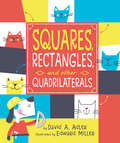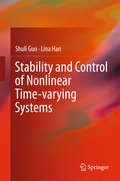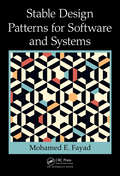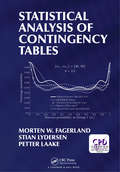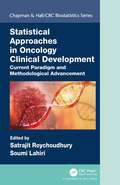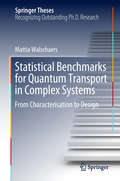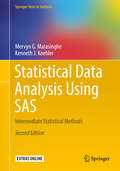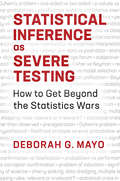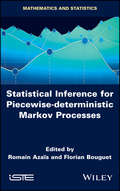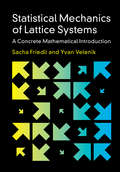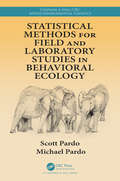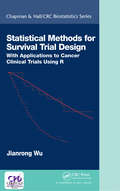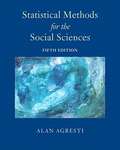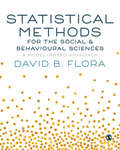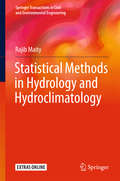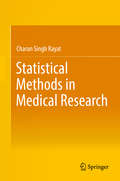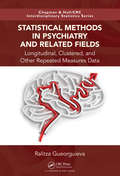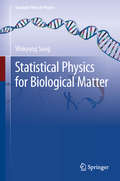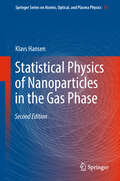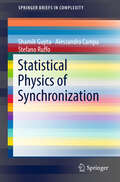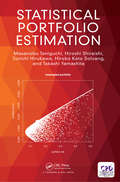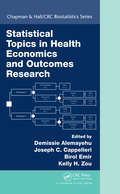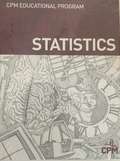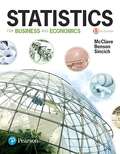- Table View
- List View
Squares, Rectangles, and Other Quadrilaterals
by David A. AdlerGeometry is demystified in a new addition to a popular and amusing series of math picture books from a trusted team. Comical cats and dogs guide kids through the essential characteristics of squares, rectangles, parallelograms, rhomboids, and other quadrilaterals. Angles and degrees are explained in words and useful visuals. Kids will get a handle on geometric vocabulary and can try out plenty of hands-on activities that will help reinforce the concepts. A glossary is included.
Stability and Control of Nonlinear Time-varying Systems
by Shuli Guo Lina HanThis book presents special systems derived from industrial models, including the complex saturation nonlinear functions and the delay nonlinear functions. It also presents typical methods, such as the classical Liapunov and Integral Inequalities methods. Providing constructive qualitative and stability conditions for linear systems with saturated inputs in both global and local contexts, it offers practitioners more concise model systems for modern saturation nonlinear techniques, which have the potential for future applications. This book is a valuable guide for researchers and graduate students in the fields of mathematics, control, and engineering.
Stable Design Patterns for Software and Systems
by Mohamed FayadAttention to design patterns is unquestionably growing in software engineering because there is a strong belief that using made to measure solutions for solving frequently occurring problems encountered throughout the design phase greatly reduces the total cost and the time of developing software products. Stable Design Patterns for Software and Systems presents a new and fresh approach for creating stable, reusable, and widely applicable design patterns. It deals with the concept of stable design patterns based on software stability as a contemporary approach for building stable and highly reusable and widely applicable design patterns. This book shows that a formation approach to discovering and creating stable design patterns accords with Alexander’s current understanding of architectural patterns. Stable design patterns are a type of knowledge pattern that underline human problem solving methods and appeal to the pattern community. This book examines software design patterns with respect to four central themes: How do we develop a solution for the problem through software stability concepts? This book offers a direct application of using software stability concepts for modeling solutions. How do we achieve software stability over time and design patterns that are effective to use? What are the unique roles of stable design patterns in modeling the accurate solution of the problem at hand and in providing stable and undisputed design for such problems? This book enumerates a complete and domain-less list of stable patterns that are useful for designing and modeling solutions for frequently recurring problems. What is the most efficient way to document the stable design patters to ensure efficient reusability? This book is an extension to the contemporary templates that are used in documenting design patterns. This book gives a pragmatic and a novel approach toward understanding the problem domain and in proposing stable solutions for engineering stable software systems, components, and frameworks.
Statistical Analysis of Contingency Tables
by Morten Fagerland Stian Lydersen Petter LaakeStatistical Analysis of Contingency Tables is an invaluable tool for statistical inference in contingency tables. It covers effect size estimation, confidence intervals, and hypothesis tests for the binomial and the multinomial distributions, unpaired and paired 2x2 tables, rxc tables, ordered rx2 and 2xc tables, paired cxc tables, and stratified tables. For each type of table, key concepts are introduced, and a wide range of intervals and tests, including recent and unpublished methods and developments, are presented and evaluated. Topics such as diagnostic accuracy, inter-rater reliability, and missing data are also covered. The presentation is concise and easily accessible for readers with diverse professional backgrounds, with the mathematical details kept to a minimum. For more information, including a sample chapter and software, please visit the authors' website.
Statistical Approaches in Oncology Clinical Development: Current Paradigm and Methodological Advancement (Chapman & Hall/CRC Biostatistics Series)
by Satrajit Roychoudhury Soumi LahiriStatistical Approaches in Oncology Clinical Development : Current Paradigm and Methodological Advancement presents an overview of statistical considerations in oncology clinical trials, both early and late phase of development. It illustrates how novel statistical methods can enrich the design and analysis of modern oncology trials. The authors include many relevant real life examples from the pharmaceutical industry and academia based on their first-hand experience. Along with relevant references, the book highlights current regulatory views. The book covers all aspects of cancer clinical trial starting from early phase development. The early part of the book covers novel phase I dose escalation design, exposure response analysis, and innovative phase II design. This includes early development strategy for cancer immunotherapy trials. The contributors also emphasized the role of biomarker and modern era of precision medicine. The second part focuses on the late stage development. This includes the application of adaptive design, safety analysis, and quality of life (QoL) data analysis. The final part discusses current regulatory perspective and challenges. Features: Covers a wide spectrum of topics related to real-life statistical challenges in oncology clinical trials. Provides a comprehensive overview of novel statistical methods to improve trial design and statistical analysis. Detailed case studies illustrate the real life applications. Satrajit Roychoudhury is a Senior Director and a member of the Statistical Research and Innovation group in Pfizer Inc. Prior to joining; he was a member of Statistical Methodology and consulting group in Novartis. He has 11 years of extensive experience in working with different phases of clinical trial. His area of research includes early phase oncology trials, survival analysis, model informed drug development, and use of Bayesian methods in clinical trials. He is industry co-chair for the ASA Biopharmaceutical Section Regulatory-Industry Workshop and has provided statistical training in major conferences including the Joint Statistical Meetings, ASA Biopharmaceutical Section Regulatory-Industry Workshop, and ICSA Applied Statistics Symposium. Soumi Lahiri has 12 years of extensive experience in working different therapeutic areas. She is the former Director of Biostatistics in Clinical Oncology, GlaxoSmithKline. She has also worked in the oncology division of Novartis Pharmaceutical Company for two years. She is an active member of the ASA Biopharmaceutical section and former chair of the membership committee.
Statistical Benchmarks for Quantum Transport in Complex Systems: From Characterisation To Design (Springer Theses)
by Mattia WalschaersThis book introduces a variety of statistical tools for characterising and designing the dynamical features of complex quantum systems. These tools are applied in the contexts of energy transfer in photosynthesis, and boson sampling. In dynamical quantum systems, complexity typically manifests itself via the interference of a rapidly growing number of paths that connect the initial and final states. The book presents the language of graphs and networks, providing a useful framework to discuss such scenarios and explore the rich phenomenology of transport phenomena. As the complexity increases, deterministic approaches rapidly become intractable, which leaves statistics as a viable alternative.
Statistical Data Analysis Using SAS: Intermediate Statistical Methods (Springer Texts in Statistics)
by Mervyn G. Marasinghe Kenneth J. KoehlerThe aim of this textbook (previously titled SAS for Data Analytics) is to teach the use of SAS for statistical analysis of data for advanced undergraduate and graduate students in statistics, data science, and disciplines involving analyzing data.The book begins with an introduction beyond the basics of SAS, illustrated with non-trivial, real-world, worked examples. It proceeds to SAS programming and applications, SAS graphics, statistical analysis of regression models, analysis of variance models, analysis of variance with random and mixed effects models, and then takes the discussion beyond regression and analysis of variance to conclude.Pedagogically, the authors introduce theory and methodological basis topic by topic, present a problem as an application, followed by a SAS analysis of the data provided and a discussion of results. The text focuses on applied statistical problems and methods. Key features include: end of chapter exercises, downloadable SAS code and data sets, and advanced material suitable for a second course in applied statistics with every method explained using SAS analysis to illustrate a real-world problem.New to this edition:• Covers SAS v9.2 and incorporates new commands• Uses SAS ODS (output delivery system) for reproduction of tables and graphics output• Presents new commands needed to produce ODS output• All chapters rewritten for clarity• New and updated examples throughout• All SAS outputs are new and updated, including graphics• More exercises and problems• Completely new chapter on analysis of nonlinear and generalized linear models• Completely new appendixMervyn G. Marasinghe, PhD, is Associate Professor Emeritus of Statistics at Iowa State University, where he has taught courses in statistical methods and statistical computing.Kenneth J. Koehler, PhD, is University Professor of Statistics at Iowa State University, where he teaches courses in statistical methodology at both graduate and undergraduate levels and primarily uses SAS to supplement his teaching.
Statistical Inference as Severe Testing: How to Get Beyond the Statistics Wars
by Deborah G. MayoMounting failures of replication in social and biological sciences give a new urgency to critically appraising proposed reforms. This book pulls back the cover on disagreements between experts charged with restoring integrity to science. It denies two pervasive views of the role of probability in inference: to assign degrees of belief, and to control error rates in a long run. If statistical consumers are unaware of assumptions behind rival evidence reforms, they can't scrutinize the consequences that affect them (in personalized medicine, psychology, etc.). The book sets sail with a simple tool: if little has been done to rule out flaws in inferring a claim, then it has not passed a severe test. Many methods advocated by data experts do not stand up to severe scrutiny and are in tension with successful strategies for blocking or accounting for cherry picking and selective reporting. Through a series of excursions and exhibits, the philosophy and history of inductive inference come alive. Philosophical tools are put to work to solve problems about science and pseudoscience, induction and falsification.
Statistical Inference for Piecewise-deterministic Markov Processes
by Romain Azais Florian BouguetPiecewise-deterministic Markov processes form a class of stochastic models with a sizeable scope of applications: biology, insurance, neuroscience, networks, finance... Such processes are defined by a deterministic motion punctuated by random jumps at random times, and offer simple yet challenging models to study. Nevertheless, the issue of statistical estimation of the parameters ruling the jump mechanism is far from trivial. Responding to new developments in the field as well as to current research interests and needs, Statistical inference for piecewise-deterministic Markov processes offers a detailed and comprehensive survey of state-of-the-art results. It covers a wide range of general processes as well as applied models. The present book also dwells on statistics in the context of Markov chains, since piecewise-deterministic Markov processes are characterized by an embedded Markov chain corresponding to the position of the process right after the jumps.
Statistical Mechanics of Lattice Systems: A Concrete Mathematical Introduction
by Sacha Friedli Yvan VelenikThis motivating textbook gives a friendly, rigorous introduction to fundamental concepts in equilibrium statistical mechanics, covering a selection of specific models, including the Curie–Weiss and Ising models, the Gaussian free field, O(n) models, and models with Kać interactions. Using classical concepts such as Gibbs measures, pressure, free energy, and entropy, the book exposes the main features of the classical description of large systems in equilibrium, in particular the central problem of phase transitions. It treats such important topics as the Peierls argument, the Dobrushin uniqueness, Mermin–Wagner and Lee–Yang theorems, and develops from scratch such workhorses as correlation inequalities, the cluster expansion, Pirogov–Sinai Theory, and reflection positivity. Written as a self-contained course for advanced undergraduate or beginning graduate students, the detailed explanations, large collection of exercises (with solutions), and appendix of mathematical results and concepts also make it a handy reference for researchers in related areas. Builds a narrative around the driving concepts, focusing on specific examples and models. Self-contained and accessible. Features numerous exercises and solutions, as well as a comprehensive appendix.
Statistical Methods for Field and Laboratory Studies in Behavioral Ecology (Chapman & Hall/CRC Applied Environmental Statistics)
by Scott Pardo Michael PardoStatistical Methods for Field and Laboratory Studies in Behavioral Ecology focuses on how statistical methods may be used to make sense of behavioral ecology and other data. It presents fundamental concepts in statistical inference and intermediate topics such as multiple least squares regression and ANOVA. The objective is to teach students to recognize situations where various statistical methods should be used, understand the strengths and limitations of the methods, and to show how they are implemented in R code. Examples are based on research described in the literature of behavioral ecology, with data sets and analysis code provided. Features: This intermediate to advanced statistical methods text was written with the behavioral ecologist in mind Computer programs are provided, written in the R language. Datasets are also provided, mostly based, at least to some degree, on real studies. Methods and ideas discussed include multiple regression and ANOVA, logistic and Poisson regression, machine learning and model identification, time-to-event modeling, time series and stochastic modeling, game-theoretic modeling, multivariate methods, study design/sample size, and what to do when things go wrong. It is assumed that the reader has already had exposure to statistics through a first introductory course at least, and also has sufficient knowledge of R. However, some introductory material is included to aid the less initiated reader. Scott Pardo, Ph.D., is an accredited professional statistician (PStat®) by the American Statistical Association. Michael Pardo is a Ph.D. is a candidate in behavioral ecology at Cornell University, specializing in animal communication and social behavior.
Statistical Methods for Survival Trial Design: With Applications to Cancer Clinical Trials Using R (Chapman & Hall/CRC Biostatistics Series)
by Jianrong WuStatistical Methods for Survival Trial Design: With Applications to Cancer Clinical Trials Using R provides a thorough presentation of the principles of designing and monitoring cancer clinical trials in which time-to-event is the primary endpoint. Traditional cancer trial designs with time-to-event endpoints are often limited to the exponential model or proportional hazards model. In practice, however, those model assumptions may not be satisfied for long-term survival trials. This book is the first to cover comprehensively the many newly developed methodologies for survival trial design, including trial design under the Weibull survival models; extensions of the sample size calculations under the proportional hazard models; and trial design under mixture cure models, complex survival models, Cox regression models, and competing-risk models. A general sequential procedure based on the sequential conditional probability ratio test is also implemented for survival trial monitoring. All methodologies are presented with sufficient detail for interested researchers or graduate students.
Statistical Methods for the Social Sciences
by Alan AgrestiStatistical methods applied to social sciences, made accessible to all through an emphasis on concepts Statistical Methods for the Social Sciences introduces statistical methods to students majoring in social science disciplines. With an emphasis on concepts and applications, this book assumes you have no previous knowledge of statistics and only a minimal mathematical background. It contains sufficient material for a two-semester course. The 5th Edition gives you examples and exercises with a variety of “real data.” It includes more illustrations of statistical software for computations and takes advantage of the outstanding applets to explain key concepts, such as sampling distributions and conducting basic data analyses. It continues to downplay mathematics–often a stumbling block for students–while avoiding reliance on an overly simplistic recipe-based approach to statistics.
Statistical Methods for the Social and Behavioural Sciences: A Model-Based Approach
by David B. FloraStatistical methods in modern research increasingly entail developing, estimating and testing models for data. Rather than rigid methods of data analysis, the need today is for more flexible methods for modelling data. In this logical, easy-to-follow and exceptionally clear book, David Flora provides a comprehensive survey of the major statistical procedures currently used. His innovative model-based approach teaches you how to: Understand and choose the right statistical model to fit your data Match substantive theory and statistical models Apply statistical procedures hands-on, with example data analyses Develop and use graphs to understand data and fit models to data Work with statistical modeling principles using any software package Learn by applying, with input and output files for R, SAS, SPSS, and Mplus. Statistical Methods for the Social and Behavioural Sciences: A Model Based Approach is the essential guide for those looking to extend their understanding of the principles of statistics, and begin using the right statistical modeling method for their own data. It is particularly suited to second or advanced courses in statistical methods across the social and behavioural sciences.
Statistical Methods for the Social and Behavioural Sciences: A Model-Based Approach
by David B. FloraStatistical methods in modern research increasingly entail developing, estimating and testing models for data. Rather than rigid methods of data analysis, the need today is for more flexible methods for modelling data. In this logical, easy-to-follow and exceptionally clear book, David Flora provides a comprehensive survey of the major statistical procedures currently used. His innovative model-based approach teaches you how to: Understand and choose the right statistical model to fit your data Match substantive theory and statistical models Apply statistical procedures hands-on, with example data analyses Develop and use graphs to understand data and fit models to data Work with statistical modeling principles using any software package Learn by applying, with input and output files for R, SAS, SPSS, and Mplus. Statistical Methods for the Social and Behavioural Sciences: A Model Based Approach is the essential guide for those looking to extend their understanding of the principles of statistics, and begin using the right statistical modeling method for their own data. It is particularly suited to second or advanced courses in statistical methods across the social and behavioural sciences.
Statistical Methods in Hydrology and Hydroclimatology (Springer Transactions in Civil and Environmental Engineering)
by Rajib MaityThis book focuses on the application of statistical methods in the field of hydrology and hydroclimatology. Among the latest theories being used in these fields, the book introduces the theory of copulas and its applications in this context. The purpose is to develop an understanding and illustrate the usefulness of the statistical techniques with detailed theory and numerous worked out examples. Apart from this, MATLAB-based codes and solutions of some worked out examples are also provided to assist the readers to handle real life data. This book presents a comprehensive knowledge of statistical techniques combining the basics of probability and the current advances in stochastic hydrology. Besides serving as a textbook for graduate courses on stochastic modeling in hydrology and related disciplines, the book offers valuable resources for researchers and professionals involved in the field of hydrology and climatology.
Statistical Methods in Medical Research
by Charan Singh RayatThis book covers all aspects of statistical methods in detail with applications. It presents solutions to the needs of post-graduate medical students, doctors and basic medical scientists for statistical evaluation of data. In present era, dependency on softwares for statistical analysis is eroding the basic understanding of the statistical methods and their applications. As a result, there are very few basic medical scientists capable of analyzing their research data due to lack of knowledge and ability. This book has been written in systematic way supported by figures and tables for basic understanding of various terms, definitions, formulae and applications of statistical methods with solved examples and graphic presentation of data to create interest in this mathematical science.
Statistical Methods in Psychiatry and Related Fields: Longitudinal, Clustered, and Other Repeated Measures Data (Chapman & Hall/CRC Interdisciplinary Statistics)
by Ralitza GueorguievaData collected in psychiatry and related fields are complex because outcomes are rarely directly observed, there are multiple correlated repeated measures within individuals, there is natural heterogeneity in treatment responses and in other characteristics in the populations. Simple statistical methods do not work well with such data. More advanced statistical methods capture the data complexity better, but are difficult to apply appropriately and correctly by investigators who do not have advanced training in statistics. This book presents, at a non-technical level, several approaches for the analysis of correlated data: mixed models for continuous and categorical outcomes, nonparametric methods for repeated measures and growth mixture models for heterogeneous trajectories over time. Separate chapters are devoted to techniques for multiple comparison correction, analysis in the presence of missing data, adjustment for covariates, assessment of mediator and moderator effects, study design and sample size considerations. The focus is on the assumptions of each method, applicability and interpretation rather than on technical details. Features Provides an overview of intermediate to advanced statistical methods applied to psychiatry. Takes a non-technical approach with mathematical details kept to a minimum. Includes lots of detailed examples from published studies in psychiatry and related fields. Software programs, data sets and output are available on a supplementary website. The intended audience are applied researchers with minimal knowledge of statistics, although the book could also benefit collaborating statisticians. The book, together with the online materials, is a valuable resource aimed at promoting the use of appropriate statistical methods for the analysis of repeated measures data. Ralitza Gueorguieva is a Senior Research Scientist at the Department of Biostatistics, Yale School of Public Health. She has more than 20 years experience in statistical methodology development and collaborations with psychiatrists and other researchers, and is the author of over 130 peer-reviewed publications.
Statistical Physics for Biological Matter (Graduate Texts in Physics)
by Wokyung SungThis book aims to cover a broad range of topics in statistical physics, including statistical mechanics (equilibrium and non-equilibrium), soft matter and fluid physics, for applications to biological phenomena at both cellular and macromolecular levels. It is intended to be a graduate level textbook, but can also be addressed to the interested senior level undergraduate. The book is written also for those involved in research on biological systems or soft matter based on physics, particularly on statistical physics.Typical statistical physics courses cover ideal gases (classical and quantum) and interacting units of simple structures. In contrast, even simple biological fluids are solutions of macromolecules, the structures of which are very complex. The goal of this book to fill this wide gap by providing appropriate content as well as by explaining the theoretical method that typifies good modeling, namely, the method of coarse-grained descriptions that extract the most salient features emerging at mesoscopic scales. The major topics covered in this book include thermodynamics, equilibrium statistical mechanics, soft matter physics of polymers and membranes, non-equilibrium statistical physics covering stochastic processes, transport phenomena and hydrodynamics. Generic methods and theories are described with detailed derivations, followed by applications and examples in biology. The book aims to help the readers build, systematically and coherently through basic principles, their own understanding of nonspecific concepts and theoretical methods, which they may be able to apply to a broader class of biological problems.
Statistical Physics of Nanoparticles in the Gas Phase (Springer Series on Atomic, Optical, and Plasma Physics #73)
by Klavs HansenThermal processes are ubiquitous and an understanding of thermal phenomena is essential for a complete description of the physics of nanoparticles, both for the purpose of modeling the dynamics of the particles and for the correct interpretation of experimental data.The second edition of this book follows the logic of first edition, with an emphasis on presentation of literature results and to guide the reader through derivations. Several topics have been added to the repertoire, notably magnetism, a fuller exposition of aggregation and the related area of nucleation theory. Also a new chapter has been added on the transient hot electron phenomenon. The book remains focused on the fundamental properties of nanosystems in the gas phase. Each chapter is enriched with additional new exercises and three Appendices provide additional useful material.
Statistical Physics of Synchronization (SpringerBriefs in Complexity)
by Shamik Gupta Alessandro Campa Stefano RuffoThis book introduces and discusses the analysis of interacting many-body complex systems exhibiting spontaneous synchronization from the perspective of nonequilibrium statistical physics. While such systems have been mostly studied using dynamical system theory, the book underlines the usefulness of the statistical physics approach to obtain insightful results in a number of representative dynamical settings. Although it is intractable to follow the dynamics of a particular initial condition, statistical physics allows to derive exact analytical results in the limit of an infinite number of interacting units. Chapter one discusses dynamical characterization of individual units of synchronizing systems as well as of their interaction and summarizes the relevant tools of statistical physics. The latter are then used in chapters two and three to discuss respectively synchronizing systems with either a first- or a second-order evolution in time. This book provides a timely introduction to the subject and is meant for the uninitiated as well as for experienced researchers working in areas of nonlinear dynamics and chaos, statistical physics, and complex systems.
Statistical Portfolio Estimation
by Masanobu Taniguchi Hiroshi Shiraishi Junichi Hirukawa Takashi Yamashita Hiroko SolvangThe composition of portfolios is one of the most fundamental and important methods in financial engineering, used to control the risk of investments. This book provides a comprehensive overview of statistical inference for portfolios and their various applications. A variety of asset processes are introduced, including non-Gaussian stationary processes, nonlinear processes, non-stationary processes, and the book provides a framework for statistical inference using local asymptotic normality (LAN). The approach is generalized for portfolio estimation, so that many important problems can be covered. This book can primarily be used as a reference by researchers from statistics, mathematics, finance, econometrics, and genomics. It can also be used as a textbook by senior undergraduate and graduate students in these fields.
Statistical Topics in Health Economics and Outcomes Research (Chapman & Hall/CRC Biostatistics Series)
by Joseph C. Cappelleri Demissie Alemayehu Birol Emir Kelly H. ZouWith ever-rising healthcare costs, evidence generation through Health Economics and Outcomes Research (HEOR) plays an increasingly important role in decision-making about the allocation of resources. Accordingly, it is now customary for health technology assessment and reimbursement agencies to request for HEOR evidence, in addition to data from clinical trials, to inform decisions about patient access to new treatment options. While there is a great deal of literature on HEOR, there is a need for a volume that presents a coherent and unified review of the major issues that arise in application, especially from a statistical perspective. Statistical Topics in Health Economics and Outcomes Research fulfils that need by presenting an overview of the key analytical issues and best practice. Special attention is paid to key assumptions and other salient features of statistical methods customarily used in the area, and appropriate and relatively comprehensive references are made to emerging trends. The content of the book is purposefully designed to be accessible to readers with basic quantitative backgrounds, while providing an in-depth coverage of relatively complex statistical issues. The book will make a very useful reference for researchers in the pharmaceutical industry, academia, and research institutions involved with HEOR studies. The targeted readers may include statisticians, data scientists, epidemiologists, outcomes researchers, health economists, and healthcare policy and decision-makers.
Statistics
by John Hayes Mary Rack David Griswold Jay Hooper Pamela Lindemer Scott CoynerNIMAC-sourced textbook
Statistics For Business And Economics
by Terry Sincich P. George Benson James McClaveThirteenth Edition, Statistics for Business and Economics introduces statistics in the context of contemporary business. Emphasizing statistical literacy in thinking, the text applies its concepts with real data and uses technology to develop a deeper conceptual understanding. Examples, activities, and case studies foster active learning while emphasizing intuitive concepts of probability and teaching readers to make informed business decisions. The Thirteenth Edition continues to highlight the importance of ethical behavior in collecting, interpreting, and reporting on data, while also providing a wealth of new and updated exercises and case studies.
